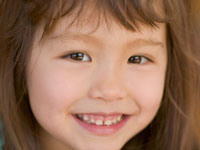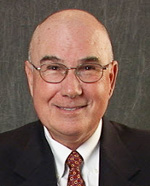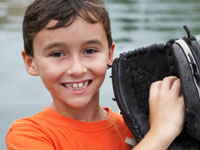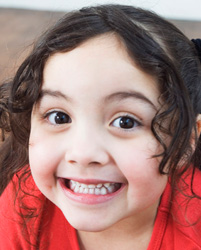Toddler And Pre-Schooler Dental Care

Almost half of the three-year-olds whom I see for a first dental examination have one or more cavities. Primary (baby) teeth do not have the enamel-strengthening advantage of fluoride during their development, because only trace amounts of fluoride pass through the placenta to the fetus. The primary teeth begin to develop during the sixth week and are calcifying at twenty weeks during pregnancy. Infants may be infected with the bacteria that cause tooth decay as early as ten months of age. This occurs when the caretaker tastes or blows on baby's food or by kissing. The decay-causing bacteria are transferred in saliva. Constant exposure of the teeth to juices, milk, or other sweetened drinks, either in a baby bottle or sippie cup, may also cause decay. Early childhood decay may result in a tendency to experience decay for the rest of your child's life. Good oral hygiene is just as important for the primary teeth as it is for the permanent teeth.
Pediatric dentists believe that toothpaste should not be used until after two years of age. A match head-sized amount should be dispensed. Some toothbrushes have a colored area on the brush head to indicate how much toothpaste to use. Do not permit your toddler to eat toothpaste from the tube. If your little one does not like toothpaste, do not use any. The fluoride in toothpaste does help to decrease decay, but sometimes brushing without toothpaste is necessary. Do not use tartar control toothpaste until the teen years. There are too many additives.
Toddler's teeth should be brushed at least once each day. Bedtime is always the most important time to brush the teeth. During the day, saliva flows over the teeth to aid in removing any food residues. Brushing should be done only by the parents, not the toddler or preschooler. A serious injury can result from permitting your child to run with a toothbrush in his or her mouth. Once all 20 primary teeth have erupted (come in), begin to brush after breakfast too. Do not permit your little one to brush first. The benefit of the fluoride in the toothpaste will be lost. Brushing the toothpaste directly onto the tooth's enamel surface will add to fluoride's strengthening effect. The toothbrush is not a toy. Chewing on the bristles will bend them. The brush must be replaced if this occurs, because it can no longer properly remove plaque. The brush should have a small, rounded head with soft bristles.
Most parents find brushing in a seated position to be easiest. Sit on the floor, the bed, or the couch and place your child's head on your lap. If your toddler is not cooperating, wrap one of your legs around both of his/her legs. Use your free hand to hold his/her hands. Your child will probably be protesting with the mouth wide open. Take advantage of the moment and brush! Brushing does not have to take two minutes. Thirty seconds may be enough time to cover all baby tooth surfaces. Do not think about time, just be sure to brush all surfaces.
A back and forth or small circular motion may be used for brushing primary teeth. Covering every tooth surface is most important. If you brush with the same pattern every time, you will be more efficient. Begin with the upper right or left primary molars. Brush from one side of the mouth to the other. Include the chewing surfaces and the side of the teeth next to the roof of the mouth. Move on to the bottom primary molars. Brush in the same manner as the upper teeth, moving from right to left, or vice versa, including the chewing surfaces and the side of the teeth next to the tongue. Ask your little one to close his or her mouth and brush the sides of the teeth all the way around next to the cheeks. Gently pull the bottom lip away from the bottom incisors (front teeth) and brush upward and away from the gum line. You may notice some light staining on these teeth when your little one is taking an oral antibiotic.
If there are no spaces between the primary teeth, flossing should begin. The same reclined position used for brushing should be used for flossing. Pretend like you are the dentist. This can become a time for not only cleaning teeth, but a time for desensitizing your child. Each time you brush or floss, he/she will become more accustomed to being in a reclined position with this activity occurring in his/her mouth. There are so many varieties of floss. If the teeth are tight together, use waxed floss. Your child may like the flavored floss, which also is easy to use with tight teeth. Use a piece of floss the length of your wrist to your elbow. Wrap the floss around your middle fingers on each hand. Palms will face upward for the top teeth and downward for the bottom teeth. Use your thumbs and index fingers to gently slide the floss between the teeth. In this case, begin with the front teeth first because they are easier to reach. Wrap the floss in a C-shape around each tooth and use an up and down motion (not back and forth) to floss. After a short time, you will be a pro! If you can manage to floss each day, that would be great, but two to three times a week is adequate.
No matter how much your child prefers to delay or avoid brushing, do it! It is much better for you to have a battle at home than for your child to experience early decay and have to undergo dental treatment at age two or three. In most cases, decay is preventable. Here's to a cavity-free future!
by Jane A. Soxman, DDS

+Jim Du Molin is a leading Internet search expert helping individuals and families connect with the right dentist in their area. Visit his author page.
Dental X-Rays For Your Child

Parents often question the need for dental X-rays (radiographs or films). Just as a broken bone or lung disease require a radiograph for a diagnosis, dental decay or other pathology (disease) of the oral cavity may require a radiograph for diagnosis. Tooth decay in children spreads rapidly in primary (baby) teeth.
Bitewing Radiograph(s)
These films, usually two, identify the presence of decay between the back (posterior) teeth. Decay between the teeth is called interproximal decay. By four and one-half years of age, the baby (primary) molars usually touch or contact each other. Interproximal decay can spread to the adjacent tooth if the teeth are in contact. If there are spaces between the primary molars, and there is no other evidence of decay, these films may not be necessary until later. A lack of spacing between the primary teeth predisposes a child to a much higher incidence of interproximal decay. Early detection permits your dentist to restore (repair) the tooth in less time and preserve tooth structure.
Periapical x-Ray
This film is used to examine the area around the tip of the root(s) or in between the roots. Primary teeth have long roots before they are resorbed (dissolved) by the pressure of the erupting permanent tooth. A root fracture after trauma, deep decay, infection, the need for root canal treatment, the presence of extra teeth, or absence of developing teeth are some of the findings with this film.
Occlusal Radiograph
This film evaluates the presence or absence of the upper and lower front teeth (incisors). It may also be used to diagnose fractures of teeth or bone and extra or missing teeth.
Panoramic x-Ray
Some pediatric dentists request this film around seven or eight years of age, when all eight permanent incisors have erupted. Although this not as accurate in diagnosing decay, it may provide an alternative if a child has a gag reflex that has prohibited taking a periapical or bitewing radiograph. The film is outside the mouth in a machine that revolves around the head. A view of the entire upper and lower jaw is obtained. This is commonly obtained by orthodontists prior to treatment. The panoramic radiograph may reveal or evaluate:
- Missing teeth
- Extra teeth
- Tumors, cysts, or other disease
- Improper position of teeth
- Broken bones after trauma
- Development of the permanent teeth
- Future crowding
- Wisdom teeth
Cephalometric Radiograph
This film ordinarily is obtained by an orthodontist in order to make a diagnosis of a child's bite (occlusion) and to determine the best treatment plan. It measures the relationship of the bones of the head and jaws.
Now, you are "in the know" for your child's next dental X-rays!
by Jane A. Soxman, DDS

+Jim Du Molin is a leading Internet search expert helping individuals and families connect with the right dentist in their area. Visit his author page.









